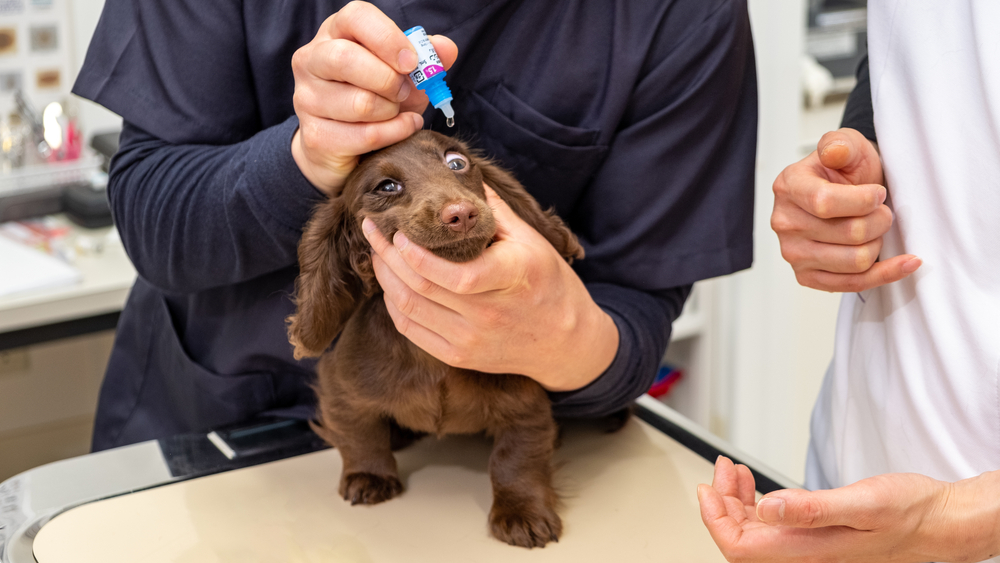“What better way to start the new year than with new life,” Mrs. Jones asked herself, as she lovingly gazed at her beloved basset hound tending to her litter of week-old roly-poly puppies. Then, this idyllic moment suddenly came to a grinding halt as Mrs. Jones realized that several of the puppies’ still-closed eyelids were swollen, with crusty debris near the corners. She immediately made an appointment with Veterinary Vision Center, where the puppies were diagnosed with neonatal ophthalmia, an eye infection that occurs beneath the closed eyelids. Thankfully, all the puppies recovered well with no lasting vision issues and headed off to new adventures with their families, but not all pets with neonatal ophthalmia or other eye infections are so lucky.
An introduction to neonatal ophthalmia and other eye infections in puppies and kittens
Although a puppy’s or kitten’s eyes don’t open until 10 to 14 days of age, this doesn’t mean the eyelids are an impenetrable barrier. Bacteria and viruses can still squeeze through and set up infection (i.e., neonatal ophthalmia) underneath the eyelid. In puppies, bacteria such as Staphylococcus and Streptococcus are responsible, while kittens may be infected by Staphylococcus, Streptococcus, Chlamydia and Mycoplasma bacteria, as well as feline herpesvirus. These organisms typically come from a dirty environment, infected birth canal or, in the case of feline herpesvirus, an infected mother or other household cat. Once their eyes are open, a puppy or kitten continues to be susceptible to eye infections, which are similar in most respects to neonatal ophthalmia.
Signs of eye infections in puppies and kittens
When your puppy’s or kitten’s eyelids are still closed, you may notice:
- Eyelids that appear swollen or bulge outward
- Mucous, pus, or clear fluid leaking from the eye corner
Once the eyelids are open, eye infections are characterized by:
- Conjunctival redness or swelling
- Abnormal eye discharge (i.e., mucous, pus, or clear fluid)
- Crusty eyelids or debris that sticks the eyelids together
- Cloudy cornea (i.e., corneal scars or ulceration)
- An eyelid adhering to the eye surface
- An eye that appears deflated
Eye infection diagnosis in puppies and kittens
If the eyelids are still closed, but Dr. Pierce suspects the puppy or kitten has neonatal ophthalmia, he will gently open the eyelids to examine the eye. Opening the eyelids earlier than they open normally does not hurt the puppy or kitten, and should have no negative long-term effects. Once the eye is visible, Dr. Pierce will examine the eye with a handheld microscope, apply fluorescein dye to look for corneal ulcers, and perform any other needed tests. Sometimes Dr. Pierce will culture the eye discharge to determine the bacteria present, and the best antibiotics for treatment. He may want to evaluate the entire litter of puppies or kittens, so ensure you ask if you should bring them all when you make the appointment. Dr. Pierce may also recommend testing the mother for the virus or bacteria that may have caused the puppies’ or kittens’ eye infections.
Eye infection treatment in puppies and kittens
Since these are viral or bacterial infections, Dr. Pierce will prescribe an antibiotic or antiviral medication as the main treatment, and may recommend warm compresses to help soothe the eyes and remove any eye debris. Monitor the infected puppies or kittens closely, and promptly call Veterinary Vision Center if their condition worsens, or you suspect littermates are developing eye infections.
Eye infection consequences in puppies and kittens

Severe infections, or those left untreated, may have permanent consequences for the puppy or kitten, including:
- Corneal scarring — Infection may leave behind a permanent sight-decreasing white corneal scar.
- Symblepharon — The conjunctiva may fuse to the cornea or other conjunctiva, preventing the eye from moving correctly, obstructing tear drainage, or decreasing vision. This occurs more commonly in cats than dogs and is associated with feline herpesvirus infections.
- Keratoconjunctivitis sicca (i.e., dry eye) — Infection can damage the tear glands and result in a temporary or permanent decrease in tear production.
- Blindness — The eye may rupture due to corneal ulceration, shrivel up, or become obscured by scar tissue or symblepharon, resulting in vision loss.
Neonatal ophthalmia and other eye infections in puppies and kittens can become serious quickly, with potentially devastating consequences. If you notice any eye problems in your new little ones, give us a call. Our Veterinary Vision Center team is here to heal—and snuggle—your precious puppies and cute kittens.







Leave A Comment